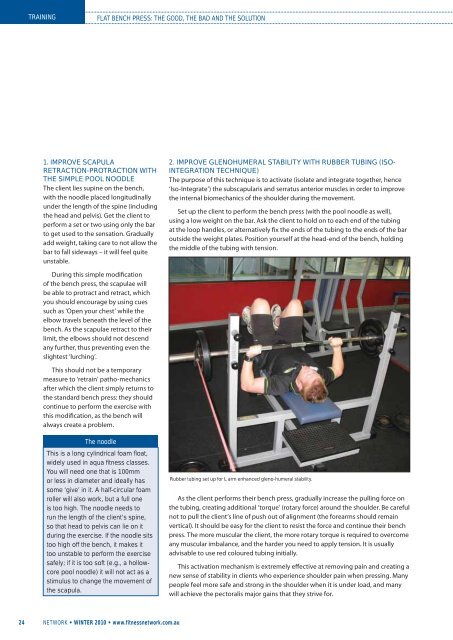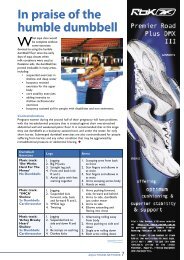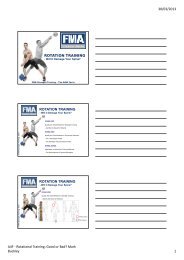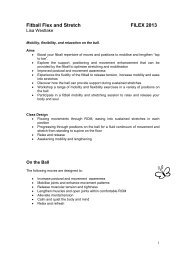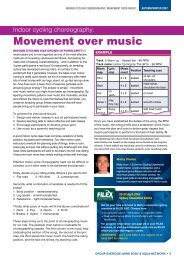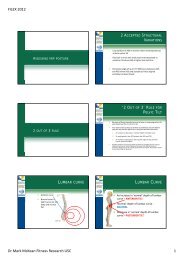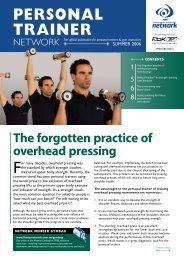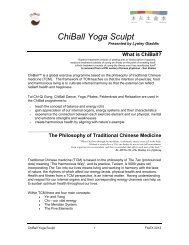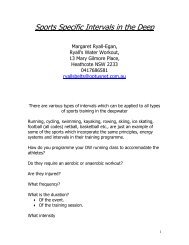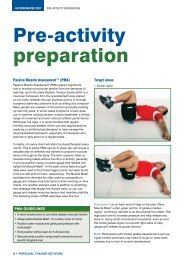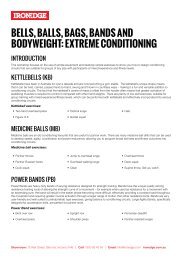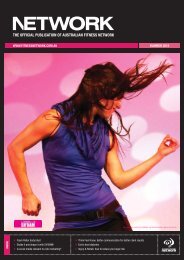CD - Australian Fitness Network
CD - Australian Fitness Network
CD - Australian Fitness Network
Create successful ePaper yourself
Turn your PDF publications into a flip-book with our unique Google optimized e-Paper software.
TRAINING<br />
FLAT BENCH PRESS: THE GOOD, THE BAD AND THE SOLUTION<br />
1. IMPROVE SCAPULA<br />
RETRACTION-PROTRACTION WITH<br />
THE SIMPLE POOL NOODLE<br />
The client lies supine on the bench,<br />
with the noodle placed longitudinally<br />
under the length of the spine (including<br />
the head and pelvis). Get the client to<br />
perform a set or two using only the bar<br />
to get used to the sensation. Gradually<br />
add weight, taking care to not allow the<br />
bar to fall sideways – it will feel quite<br />
unstable.<br />
During this simple modifi cation<br />
of the bench press, the scapulae will<br />
be able to protract and retract, which<br />
you should encourage by using cues<br />
such as ‘Open your chest’ while the<br />
elbow travels beneath the level of the<br />
bench. As the scapulae retract to their<br />
limit, the elbows should not descend<br />
any further, thus preventing even the<br />
slightest ‘lurching’.<br />
This should not be a temporary<br />
measure to ‘retrain’ patho-mechanics<br />
after which the client simply returns to<br />
the standard bench press: they should<br />
continue to perform the exercise with<br />
this modifi cation, as the bench will<br />
always create a problem.<br />
The noodle<br />
This is a long cylindrical foam fl oat,<br />
widely used in aqua fi tness classes.<br />
You will need one that is 100mm<br />
or less in diameter and ideally has<br />
some ‘give’ in it. A half-circular foam<br />
roller will also work, but a full one<br />
is too high. The noodle needs to<br />
run the length of the client’s spine,<br />
so that head to pelvis can lie on it<br />
during the exercise. If the noodle sits<br />
too high off the bench, it makes it<br />
too unstable to perform the exercise<br />
safely; if it is too soft (e.g., a hollowcore<br />
pool noodle) it will not act as a<br />
stimulus to change the movement of<br />
the scapula.<br />
24 NETWORK WINTER 2010 www.fitnessnetwork.com.au<br />
2. IMPROVE GLENOHUMERAL STABILITY WITH RUBBER TUBING (ISO-<br />
INTEGRATION TECHNIQUE)<br />
The purpose of this technique is to activate (isolate and integrate together, hence<br />
‘Iso-Integrate’) the subscapularis and serratus anterior muscles in order to improve<br />
the internal biomechanics of the shoulder during the movement.<br />
Set up the client to perform the bench press (with the pool noodle as well),<br />
using a low weight on the bar. Ask the client to hold on to each end of the tubing<br />
at the loop handles, or alternatively fi x the ends of the tubing to the ends of the bar<br />
outside the weight plates. Position yourself at the head-end of the bench, holding<br />
the middle of the tubing with tension.<br />
Rubber tubing set up for L arm enhanced gleno-humeral stability.<br />
As the client performs their bench press, gradually increase the pulling force on<br />
the tubing, creating additional ‘torque’ (rotary force) around the shoulder. Be careful<br />
not to pull the client’s line of push out of alignment (the forearms should remain<br />
vertical). It should be easy for the client to resist the force and continue their bench<br />
press. The more muscular the client, the more rotary torque is required to overcome<br />
any muscular imbalance, and the harder you need to apply tension. It is usually<br />
advisable to use red coloured tubing initially.<br />
This activation mechanism is extremely eff ective at removing pain and creating a<br />
new sense of stability in clients who experience shoulder pain when pressing. Many<br />
people feel more safe and strong in the shoulder when it is under load, and many<br />
will achieve the pectoralis major gains that they strive for.


